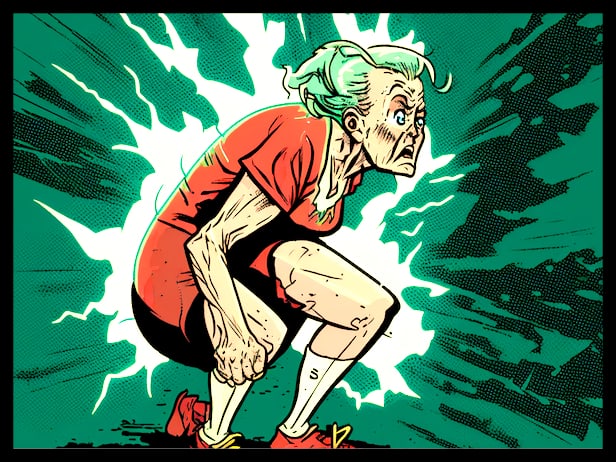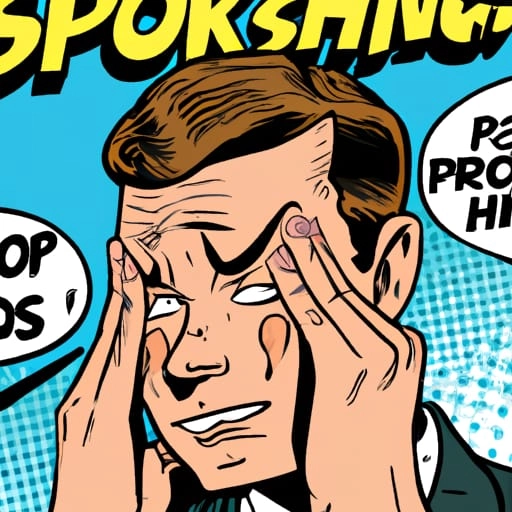How Can Anxiety And Stress Cause Joint Pain And Stiffness?
Anxiety can cause joint pain and stiffness through muscle tension, inflammation, and poor sleep quality. The gut-brain connection may also play a role. Managing stress and anxiety through relaxation techniques, exercise, therapy, and gut health support can help reduce the impact on joint health.

Anxiety is common among patients presenting to primary care with joint pain.
Stress can cause joint pain and stiffness through muscle tension, inflammation, and poor sleep quality.
The gut-brain connection may also play a role. Managing stress and anxiety through relaxation techniques, exercise, therapy, and gut health support can help reduce the impact on joint health.
Stress can increase your perception of pain.
Stress can cause you to tense up muscles.
Anxiety can also have an impact on your posture.
Introduction:
Anxiety and stress are common emotional experiences that most of us have encountered at some point in our lives. While we often associate these emotions with mental or emotional symptoms, they can also have physical manifestations that affect our overall health.
One such physical symptom is joint pain and stiffness.
Joint pain and stiffness are potential symptoms of anxiety and stress. These conditions can be particularly frustrating for those who experience them, as they can limit mobility and affect daily activities. While there are many potential causes of joint pain and stiffness, understanding the connection between these symptoms and anxiety is important for those who experience them. In this article, we will explore how anxiety and stress can cause joint pain and stiffness and offer tips for managing these symptoms.
The Connection Between Stress and Joint Pain
Stress can have a significant impact on our physical health, including joint pain and stiffness.
When we experience stress, our body responds by producing cortisol, a hormone that can increase inflammation in the body, including in the joints. This inflammation can lead to pain and stiffness, making it difficult to move or perform daily activities.
Additionally, stress can cause our muscles to tense up, which can lead to pressure on the joints and contribute to joint pain and stiffness. This muscle tension can be particularly problematic for those who experience chronic stress or anxiety, as it can exacerbate joint pain over time.
Research studies have found that individuals who experience high levels of stress are more likely to report joint pain and stiffness compared to those who experience lower levels of stress. One study published in the Annals of Behavioral Medicine found that stress was associated with increased joint pain in individuals with osteoarthritis.
Symptoms In The Joints
Anxiety is another common emotional experience that can have physical manifestations, including muscle tension. When we experience anxiety, our muscles tend to tighten, leading to increased tension and discomfort. This muscle tension can occur throughout the body, including in the joints, and can contribute to pain and stiffness.
Muscle tension can be particularly problematic for those who experience chronic anxiety, as the tension can become chronic and lead to ongoing pain and stiffness in the joints. Additionally, anxiety can exacerbate existing joint pain and make it more difficult to manage.
The Impact of Anxiety and Stress on Sleep Quality
Anxiety can significantly impact our sleep quality, leading to increased inflammation and exacerbating joint pain and stiffness. When we experience stress, it can be difficult to fall asleep or stay asleep, leading to a decrease in the amount and quality of our sleep. This lack of sleep can trigger an inflammatory response in the body, leading to increased joint pain and stiffness.
Fortunately, there are several tips for improving sleep quality that can help reduce the impact of anxiety on joint health. One effective tip is to establish a regular sleep routine, which can help regulate our body’s sleep-wake cycle and promote better sleep quality.
Additionally, avoiding computer, tablet, phone or TV screens before bed can help improve sleep quality. The blue light emitted by electronic devices can disrupt our body’s natural sleep-wake cycle and make it more difficult to fall asleep.
Another helpful tip for improving sleep quality is to create a relaxing sleep environment. This can include dimming the lights, reducing noise levels, and keeping the bedroom at a cool, comfortable temperature.
Finally, practicing relaxation techniques, such as deep breathing or meditation, before bed can help reduce anxiety and promote relaxation, leading to better sleep quality.
The Gut-Brain Connection
Research has shown that there is a strong connection between our gut and brain, known as the gut-brain connection. Stress and anxiety can affect this connection, leading to inflammation and joint pain. When we experience stress and anxiety, it can alter the balance of bacteria in our gut, potentially leading to a condition known as leaky gut syndrome.
Leaky gut syndrome is a condition where the intestinal lining becomes permeable, allowing bacteria and toxins to leak into the bloodstream. This can trigger an inflammatory response in the body, leading to joint pain and stiffness. Additionally, leaky gut syndrome can lead to nutrient deficiencies, which can impact joint health.
There are several tips for supporting gut health, which can help reduce the impact of stress and anxiety on joint health. Eating a balanced diet that includes plenty of fruits and vegetables, lean protein, and healthy fats can help promote a healthy gut microbiome. Additionally, taking probiotics or consuming fermented foods, such as yogurt and kimchi, can help support gut health.
Reducing stress and anxiety through relaxation techniques, exercise, and therapy can also help support gut health and reduce inflammation in the body.

Reduce Stress to Reduce Joint Pain
Managing stress and anxiety is important not only for our mental and emotional health but also for our physical health, including joint health.
In addition, making lifestyle changes, such as maintaining a healthy weight and staying active, can also help reduce your risk of developing joint pain and stiffness. Engaging in regular exercise can help improve your blood supply, strengthen your muscles, and improve your overall physical health. However, it’s important to consult with your health care provider before beginning any exercise program.
There are several types of exercises that can be particularly effective in improving joint stiffness and reducing pain associated with stress and anxiety.
These include:
Aerobic exercises, such as walking, cycling, or swimming, which can help improve blood flow and reduce inflammation in the joints.
Strength training exercises, such as weightlifting or bodyweight exercises, can help improve muscle tone and reduce muscle tension, which can also contribute to joint pain and stiffness.
Additionally, low-impact exercises such as yoga, tai chi, or Pilates can help improve flexibility and range of motion in the joints, making them particularly effective for those with joint pain and stiffness. Incorporating these types of exercises into a regular fitness routine can be an effective way to manage stress, anxiety, and joint pain.
There are several types of therapy that have been shown to be effective in reducing stress and anxiety.
Cognitive-behavioral therapy (CBT) is one type of therapy that focuses on identifying and changing negative thought patterns and behaviors that contribute to stress and anxiety. It can be particularly helpful for those who struggle with anxious thoughts and worries.
Physical therapy is a good idea for those experiencing joint pain and stiffness. A physical therapist can develop an individualized plan to help you manage your pain, reduce muscle tension, and improve your overall physical health. Progressive muscle relaxation and other relaxation techniques can also be helpful in reducing anxiety symptoms, emotional stress, and muscle pain.
Managing stress levels is also essential in preventing joint pain and stiffness. Anxiety disorders and stressful situations can increase your risk of developing chronic conditions that affect your joints. Finding ways to manage your stress, such as deep breathing or mindfulness-based stress reduction, can be an effective way to reduce your risk of developing joint pain and stiffness.
Mindfulness-based therapy, such as mindfulness-based stress reduction (MBSR), is another effective type of therapy that can help reduce stress and anxiety. This type of therapy focuses on helping individuals develop mindfulness skills and techniques that can be used to manage stressful situations.
Other types of therapy, such as psychodynamic therapy or interpersonal therapy, can also be effective in reducing stress by helping individuals gain insight into the underlying causes of their stress and anxiety.
It’s important to note that different types of therapy may work better for different individuals, so it’s important to speak with a mental health professional to determine which type of therapy may be best for your individual needs.
In the early stages of joint pain, pain relief can be achieved through lifestyle changes and physical therapy. A physical therapist can help develop a personalized exercise plan to improve range of motion and reduce joint discomfort. In some cases, steroid injections or other medical treatments may be necessary to control disease progression and manage pain. Healthcare providers may also refer patients to a mental health professional if stress and anxiety are contributing to chronic pain.

More Background On Pain In Your Joints
When dealing with joint pain and other arthritis symptoms, it’s important to understand the most common cause and potential side effects of treatments. Chronic stress and anxiety can exacerbate joint pain and contribute to a complex anxiety symptom profile. A mental health professional can provide guidance on managing stress and anxiety in the context of chronic illness. It’s also important to communicate specific symptoms to healthcare providers, as this can help with diagnosis and disease control. Half of people with diabetic neuropathy experience joint disorders, which can lead to chronic pain and discomfort. Overall, there is a wide range of symptoms and potential treatments for joint pain and stiffness, and it’s important to work with healthcare providers to find the best way to manage symptoms and improve overall health.
Joint pain and stiffness are common symptoms of many medical conditions, including different types of arthritis. One of the most common forms of arthritis is rheumatoid arthritis, an autoimmune disorder in which the immune system attacks the body’s connective tissues, including the joints. If you experience joint pain, your health care provider may recommend blood tests and a physical examination to identify the underlying cause.
Chronic pain and joint discomfort can also be caused by psoriatic arthritis, another type of arthritis that causes skin rashes, muscle tension, and joint pain. It’s essential to identify and treat the underlying medical conditions that can lead to joint pain and stiffness. Understanding the risk factors, including age, family history, environmental factors, and lifestyle habits, can help you take steps to reduce your risk of developing chronic conditions that affect your joints.
Inflammation and Mental Health
When you experience joint pain, your body responds with an inflammatory response, leading to inflammation in the affected joint and surrounding tissues. This inflammation can result in severe pain and stiffness, limiting your mobility and making it difficult to perform daily activities. In severe cases, joint damage can occur, leading to long-term, chronic disease.
Blood vessels play a crucial role in joint health. They supply the joint with blood, which is necessary for providing nutrients and oxygen to the joint tissues. Poor blood flow to the joints can lead to joint damage, which can cause joint pain and stiffness. In the case of the most common form of arthritis, osteoarthritis, joint damage occurs due to wear and tear on the joint tissues over time. Carpal tunnel syndrome is another condition that can affect blood vessels, causing compression of the median nerve, which can lead to numbness, tingling, and pain in the hand and wrist. A thorough medical history and physical examination can help healthcare providers diagnose conditions that affect the blood vessels and joints.
High blood pressure is a common medical condition that can affect joint health. It can contribute to the development of arthritis symptoms and increase the risk of heart attack and stroke. In some cases, high blood pressure can also cause damage to blood vessels, which can lead to blood clots and affect blood supply to the affected area. Medical treatment for high blood pressure can help reduce the risk of joint damage and improve overall health.
Panic attacks and high stress levels can lead to a stress response in the body that affects the nervous system and soft tissues.
Systemic lupus erythematosus is a chronic autoimmune disease that can cause a wide range of symptoms, including joint pain, fatigue, and skin rashes.
Sharp pain in the chest or other parts of the body can be a sign of a serious medical condition, such as heart attack or kidney failure. In rare cases, certain infections such as Lyme disease can also affect joint health.
Bone spurs can also contribute to joint pain and stiffness, particularly in the big toe and lower back. Physical conditions such as median nerve compression or neck pain can also lead to joint discomfort. Raynaud’s phenomenon is a condition that affects blood vessels in the fingers and toes, causing them to turn white or blue and feel numb or painful in response to cold temperatures or stress.

Conclusion
In conclusion, joint pain and stiffness can be caused by a variety of factors, including autoimmune disorders, viral infections, and environmental factors. Identifying the underlying cause of your joint pain is essential in developing an effective treatment plan. By managing your stress levels, making lifestyle changes, and working with your health care provider to identify potential medical conditions, you can take steps to improve your overall health and reduce your risk of developing chronic conditions that affect your joints.
References
Arthritis Foundation: https://www.arthritis.org/health-wellness/healthy-living/emotional-well-being/stress-management/stress-and-arthritis
The Arthritis Foundation is a nonprofit organization dedicated to providing education and support to individuals with arthritis. Their website offers a variety of resources related to arthritis, including information on the connection between stress and arthritis. The page on stress and arthritis provides an overview of how stress can affect arthritis symptoms, as well as tips for managing stress to improve arthritis symptoms.
National Institute of Mental Health: https://www.nimh.nih.gov/health/publications/stress/index.shtml
The National Institute of Mental Health is a research organization dedicated to improving the understanding and treatment of mental health conditions. Their website offers a variety of resources related to mental health, including information on stress and its effects on the body. The page on stress provides an overview of the physical and emotional effects of stress, as well as tips for managing stress to improve overall health.
American Psychological Association: https://www.apa.org/topics/stress
The American Psychological Association is a professional organization dedicated to promoting psychology as a science and profession. Their website offers a variety of resources related to mental health, including information on stress and its effects on the body. The page on stress provides an overview of the physical and emotional effects of stress, as well as tips for managing stress to improve overall health.
Centers for Disease Control and Prevention: https://www.cdc.gov/arthritis/basics/stress-and-arthritis.html
The Centers for Disease Control and Prevention is a national public health institute dedicated to protecting and improving the health of individuals and communities. Their website offers a variety of resources related to health, including information on arthritis and stress. The page on stress and arthritis provides an overview of how stress can affect arthritis symptoms, as well as tips for managing stress to improve arthritis symptoms.






